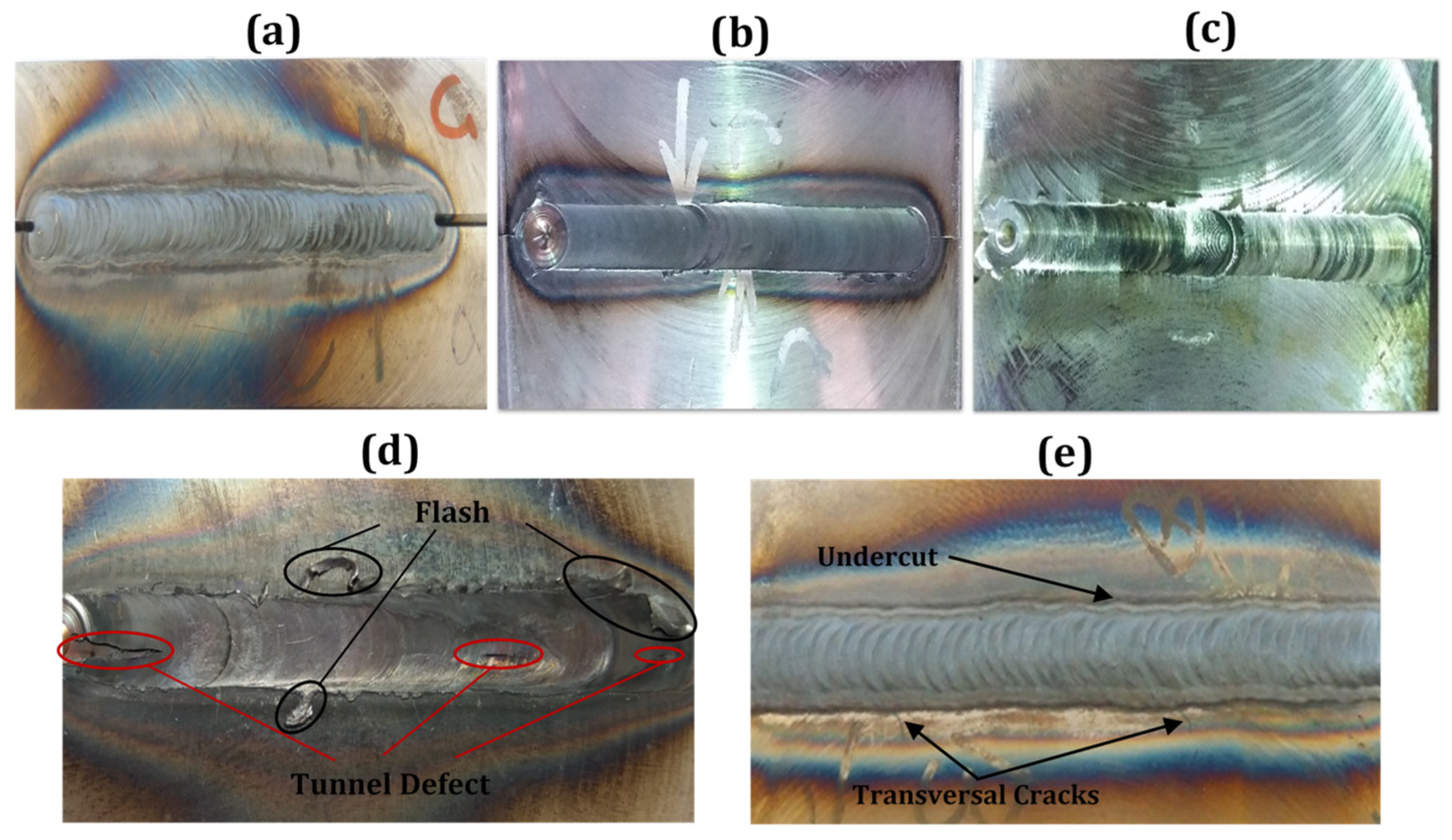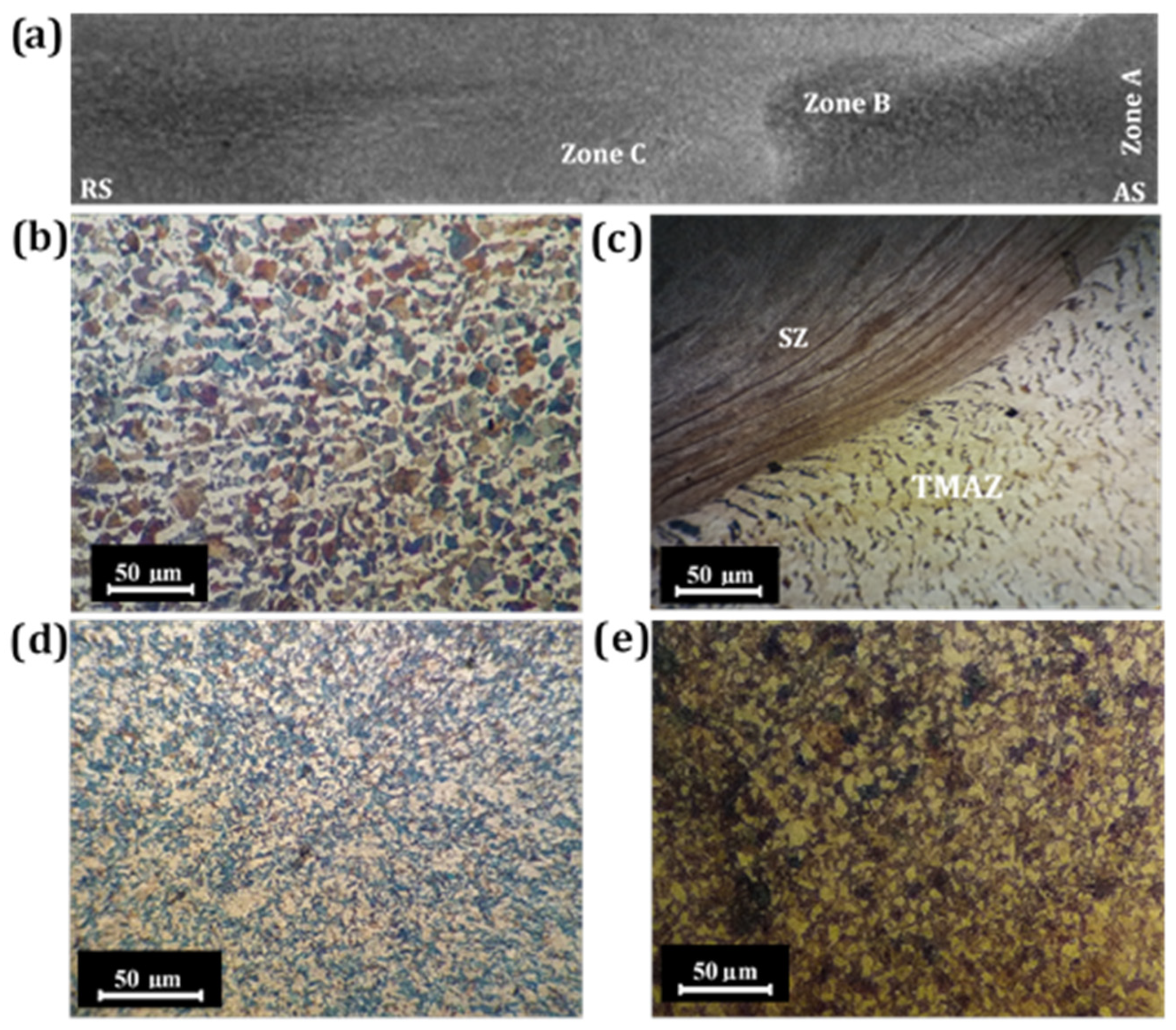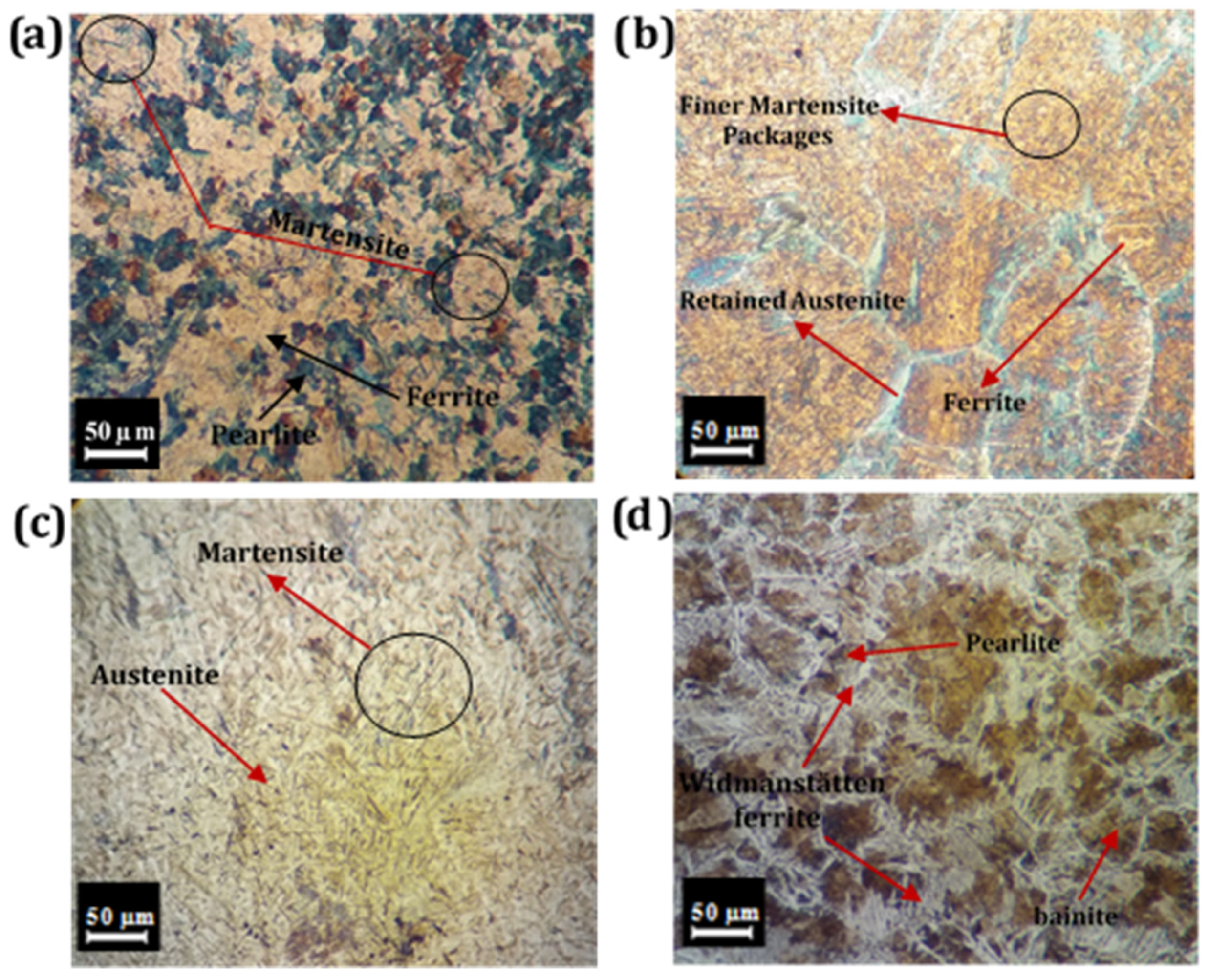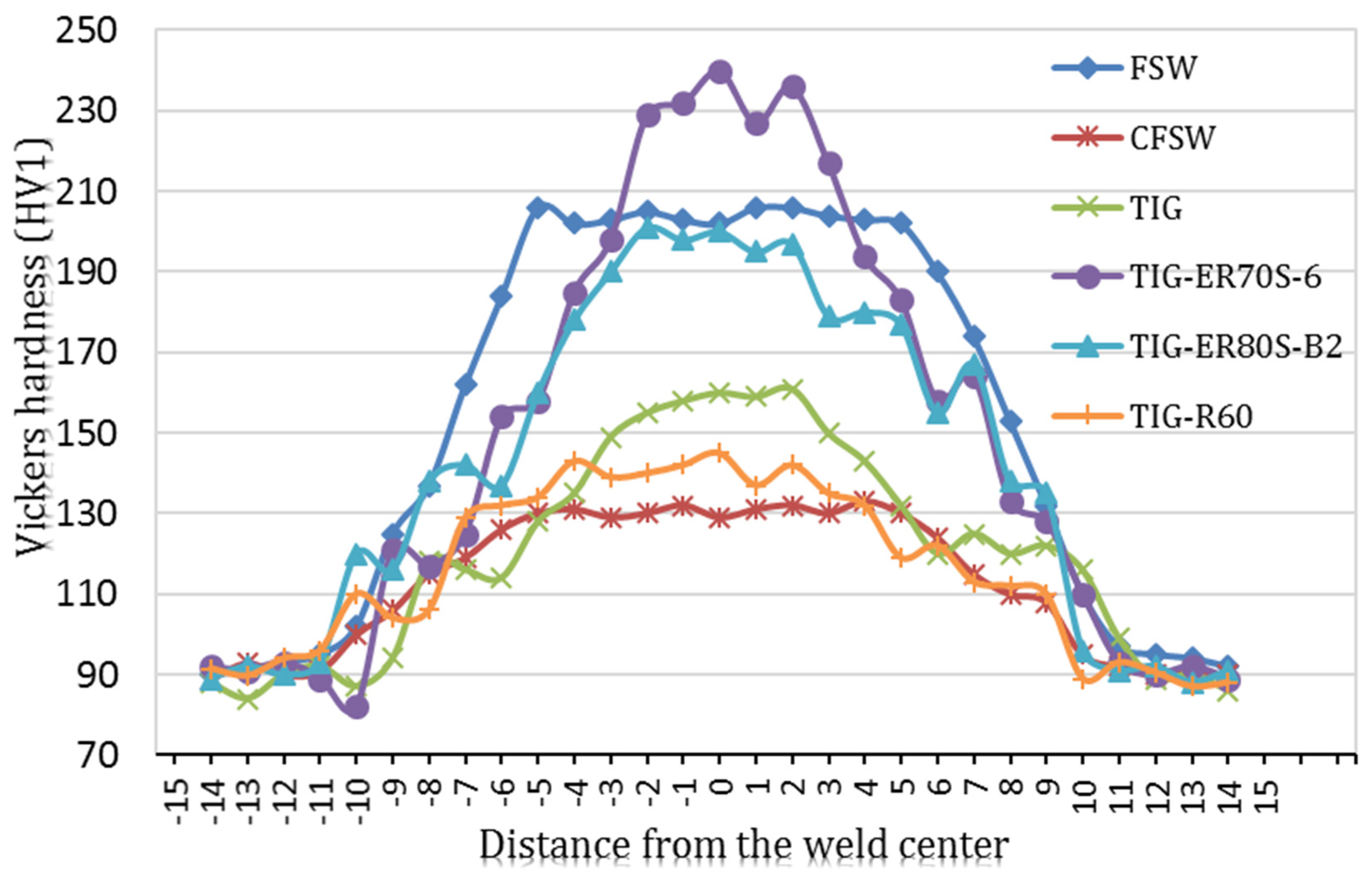Characterization of Friction Stir and TIG Welded CK45 Carbon Steel
Abstract
:1. Introduction
2. Materials and Methods
3. Results
3.1. Macro- and Microscopic Analysis
3.2. Mechanical Properties
3.2.1. Hardness
3.2.2. Tensile Properties
4. Conclusions
- Sound joints could successfully be accomplished via CFSW procedure with the following parameters: rotational speed 950 (rpm), traverse speed 24 (mm/min), plunge depth 0.4 (mm), and tilt angle 0.3 (degree);
- The optimal mechanical property combination was accomplished in CFSWed plates, wherein the microstructure resembled BM. However, the SZ of CFSWed plates contained a finer ferrite-pearlite microstructure, owing to the lower heat input generated, in comparison to typical FSW;
- In TIG joints, the nugget zone (NZ) of welded samples with ER70S-6 and ER80S-B2 filler metals possessed essentially a martensite structure that was attributed to the presence of Mo in both BM and filler metals, which not only increased the hardenability of the materials, but also reduced the weldability of plates dramatically. In contrast, the NZ of a TIG welded sample using R60 filler metal consisted of a mix of bainite and Widmanstätten ferrite (WF) structure, thereby imparting reasonable mechanical properties;
- From the industrial application point of view, friction stir welding process stays highly competitive in this fast-changing world embracing new technologies due to both energy-saving as well as preventing the joints from getting riddled with defects, which are often seen in the case of fusion welding methods.
Author Contributions
Funding
Institutional Review Board Statement
Informed Consent Statement
Data Availability Statement
Acknowledgments
Conflicts of Interest
References
- Fujii, H.; Sato, T.; Lu, S.; Nogi, K. Development of an advanced A-TIG (AA-TIG) welding method by control of Marangoni convection. Mater. Sci. Eng. A 2008, 495, 296–303. [Google Scholar] [CrossRef]
- Ganesh, K.; Vasudevan, M.; Balasubramanian, K.; Chandrasekhar, N.; Vasantharaja, P. Thermo-mechanical analysis of TIG welding of AISI 316LN stainless steel. Mater. Manuf. Process. 2014, 29, 903–909. [Google Scholar] [CrossRef]
- Tseng, K.-H.; Lin, P.-Y. UNS S31603 stainless steel tungsten inert gas welds made with microparticle and nanoparticle oxides. Materials 2014, 7, 4755–4772. [Google Scholar] [CrossRef] [PubMed] [Green Version]
- Correa, E.; Costa, S.; Santos, J. Studies on weldability of iron-based powder metal alloys using pulsed gas tungsten arc welding process. J. Mater. Process. Technol. 2009, 209, 3937–3942. [Google Scholar] [CrossRef]
- Juang, S.; Tarng, Y. Process parameter selection for optimizing the weld pool geometry in the tungsten inert gas welding of stainless steel. J. Mater. Process. Technol. 2002, 122, 33–37. [Google Scholar] [CrossRef]
- Mishra, R.S.; Ma, Z. Friction stir welding and processing. Mater. Sci. Eng. R 2005, 50, 1–78. [Google Scholar] [CrossRef]
- Aghajani Derazkola, H.; García, E.; Eyvazian, A.; Aberoumand, M. Effects of rapid cooling on properties of Aluminum-Steel friction stir welded joint. Materials 2021, 14, 908. [Google Scholar] [CrossRef] [PubMed]
- Laieghi, H.; Alipour, S.; Mostafapour, A. Heat-assisted friction stir welding of polymeric nanocomposite. Sci. Technol. Weld. Join. 2019, 25, 1–10. [Google Scholar] [CrossRef]
- Laska, A.; Szkodo, M. Manufacturing parameters, materials, and welds properties of butt friction stir welded joints–Overview. Materials 2020, 13, 4940. [Google Scholar] [CrossRef] [PubMed]
- Pramanik, A.; Littlefair, G.; Basak, A. Weldability of duplex stainless steel. Mater. Manuf. Process. 2015, 30, 1053–1068. [Google Scholar] [CrossRef]
- Tiwari, A.; Singh, P.; Pankaj, P.; Biswas, P.; Kore, S.D. FSW of low carbon steel using tungsten carbide (WC-10 wt.% Co) based tool material. J. Mech. Sci. Technol. 2019, 33, 4931–4938. [Google Scholar] [CrossRef]
- Sato, Y.; Yamanoi, H.; Kokawa, H.; Furuhara, T. Microstructural evolution of ultrahigh carbon steel during friction stir welding. Scr. Mater. 2007, 57, 557–560. [Google Scholar] [CrossRef]
- Cui, L.; Fujii, H.; Tsuji, N.; Nogi, K. Friction stir welding of a high carbon steel. Scr. Mater. 2007, 56, 637–640. [Google Scholar] [CrossRef]
- Fujii, H.; Ueji, R.; YTakada, H.K.; Tsuji, N.; Nakata, K.; Nogi, K. Friction stir welding of ultrafine grained interstitial free steels. Mater. Trans. 2006, 47, 239–242. [Google Scholar] [CrossRef] [Green Version]
- Lienert, T.; Stellwag, W.L., Jr.; Grimmett, B.B.; Warke, R.W. Friction stir welding studies on mild steel. Weld. J. 2003, 82, 1. [Google Scholar] [CrossRef]
- Singh, R. Applied Welding Engineering: Processes, Codes, and Standards; Butterworth-Heinemann: Oxford, UK, 2020. [Google Scholar]
- ASTM E384-05a. Standard Test Method for Microindentation Hardness of Materials. Eff. Heat Input Microstruct. Toughness 2005, 279, 1–33. [Google Scholar]
- Saeid, T.; Abdollah-Zadeh, A.; Assadi, H.; Ghaini, F.M. Effect of friction stir welding speed on the microstructure and mechanical properties of a duplex stainless steel. Mater. Sci. Eng. A 2008, 496, 262–268. [Google Scholar] [CrossRef]
- Feng, C.; Qin, G.; Meng, X.; Geng, P. Defect evolution of 409L stainless steel in high-speed TIG welding. Mater. Manuf. Process. 2020, 35, 179–186. [Google Scholar] [CrossRef]
- Schneider, J.; Nunes, A. Characterization of plastic flow and resulting microtextures in a friction stir weld. Metall. Mater. Trans. B 2004, 35, 777–783. [Google Scholar] [CrossRef]
- Tathgir, S.; Rathod, D.W.; Batish, A. A-TIG welding process for enhanced-penetration in Duplex stainless-steel: Effect of activated fluxes. Mater. Manuf. Process. 2019, 34, 1659–1670. [Google Scholar] [CrossRef]
- Haghshenas, M.; Gerlich, A. Joining of automotive sheet materials by friction-based welding methods: A review. Eng. Sci. Technol. Int. J. 2018, 21, 130–148. [Google Scholar] [CrossRef]







| Type | Chemical Composition (%) | |||||||||
|---|---|---|---|---|---|---|---|---|---|---|
| Fe | C | Si | P | S | Cr | Mo | Ni | Mn | Cr, Mo, Ni | |
| CK45 | balance | 0.42–0.5 | 0.19 | ≤0.3 | ≤0.035 | ≤0.4 | ≤0.1 | ≤0.4 | 0.5–0.8 | ≤0.63 |
| R60 | balance | 0.1 | 0.17 | 0.013 | 0.016 | 0.07 | 0.02 | 0.1 | 0.93 | - |
| ER70S-6 | balance | 0.08 | 0.8 | 0.014 | 0.03 | 0.025 | 0.4 | 0.013 | 1.44 | - |
| ER80S-B2 | balance | 0.1 | 0.4 | 0.02 | 0.02 | 1.2 | 0.4 | 0.2 | 0.4 | - |
| Welding Conditions | |||
|---|---|---|---|
| Welding Type | Process Parameters | Unit | Values |
| TIG | Welding current | (A) | 120 ± 10 |
| Arc length | (mm) | 2 | |
| Welding speed | (mm/s) | 1.1 | |
| Voltage | (V) | 12–12.8 | |
| Shielding gas | - | Argon | |
| Filler material | - | R60, ER70S-6, ER80S-B2 | |
| FSW | Rotational speed | (rpm) | 950 |
| Traverse speed | (mm/min) | 24 | |
| Plunge depth | (mm) | 0.4 | |
| Tilt angle | (degree) | 3 | |
| Sample | Yield Strength (MPa) | Ultimate Tensile Strength (MPa) | Total Elongation (%) |
|---|---|---|---|
| Base material | 224 ± 1 | 381 ± 2 | 37 ± 2 |
| FSW | 459 ± 3 | 757 ± 5 | 10 ± 1 |
| CFSW | 477 ± 3 | 570 ± 4 | 13 ± 1 |
| TIG without filler metal | 395 ± 2 | 551 ± 4 | 11 ± 1 |
| TIG with ER70S-6 filler metal | 551 ± 5 | 878 ± 7 | 4 ± 0.3 |
| TIG with ER80S-B2 filler metal | 488 ± 4 | 766 ± 6 | 8 ± 0.6 |
| TIG with R60 filler metal | 311 ± 3 | 483 ± 5 | 14 ± 1 |
Publisher’s Note: MDPI stays neutral with regard to jurisdictional claims in published maps and institutional affiliations. |
© 2021 by the authors. Licensee MDPI, Basel, Switzerland. This article is an open access article distributed under the terms and conditions of the Creative Commons Attribution (CC BY) license (https://creativecommons.org/licenses/by/4.0/).
Share and Cite
Rafati, M.; Mostafapour, A.; Laieghi, H.; Somani, M.C.; Kömi, J. Characterization of Friction Stir and TIG Welded CK45 Carbon Steel. Materials 2021, 14, 4098. https://doi.org/10.3390/ma14154098
Rafati M, Mostafapour A, Laieghi H, Somani MC, Kömi J. Characterization of Friction Stir and TIG Welded CK45 Carbon Steel. Materials. 2021; 14(15):4098. https://doi.org/10.3390/ma14154098
Chicago/Turabian StyleRafati, Mohammadreza, Amir Mostafapour, Hossein Laieghi, Mahesh Chandra Somani, and Jukka Kömi. 2021. "Characterization of Friction Stir and TIG Welded CK45 Carbon Steel" Materials 14, no. 15: 4098. https://doi.org/10.3390/ma14154098







